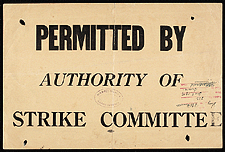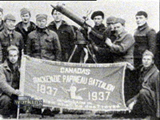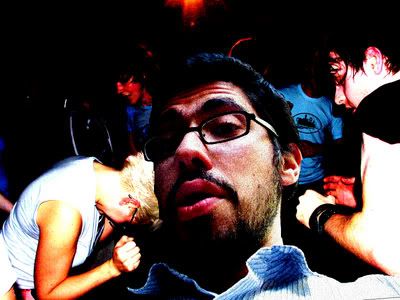
THRUSH HERMIT - Have you ever seen that video for "The Day We Hit The Coast"? Where they put on all that fur trading clothes and walk through the woods in late winter on a sunny day? And at the end they reach a stage by a stream and rock the fuck out? Yes, it was very Canadian. Chalk Clayton Park up as one of the best albums of all time, let alone Canadian albums.

MARC GARNEAU - Ladies and gentlemen, the first Canadian in space! Need I say more?
*FUN FACT! Canada was the third country to make it to space. Researchers like The Mars Society of Canada are calling for a Canadian led mission to Mars, which apparently is not all that impossible.

STOMPIN TOM CONNORS - In his book On the Cold Road, Dave Bidini of the Rheostatics recalls his trip to Ireland as a youngster: "[Stompin Tom's] My Stompin Grounds became my way of communicating what Canada was like without having to stumble through my own hazy ideas about home (Tom, after all, had a song naming the provinces and their capitals, a handy geography lesson in under three minutes)...Tom's voice drew me back across the ocean, and the songs about bobcats and Wilf Carter that I'd once been embarrassed to listen to anchored my identity in a culture where nationhood was everything." Sure, Tom's a real mainstream name, which in Canada generally means misplaced in CBC specials and overcelebrated by too many journalists, and he's not the first thing a street-cred obsessed indie kid would toss into the jukebox. But in all seriousness, this man is a hard-nosed rebel who doesn't take shit. He was a moderately well-known artist in the country, folk and traditional circuits through the 60s and 70s, but he shunned fame and the music industry in Canada at large, sending back all his Junos and hanging his boots to rest until the early 90's, when Dave Bidini helped resurrect his career and put him on the path to iconhood (but to me he's very much an iconoclast).

THE PEOPLE OF WINNIPEG, 1919 - Most people forget that this quiet Canadian city was the only place in North America that came anywhere close to a modern revolution? For six weeks, the people of Winnipeg took part in a prolonged general strike that put the city at the centre of global news for a whole summer. For the duration of the strike, which was supported from the get-go by the police force and fire department, the Strike Committee and those overwhelming number of people who cooperated with them maintained a syndicalist municipal government that only a few cities around the world succeeded in even attempting. The Strike did not die under its own weight. On the contrary, it was killed by a robust RCMP, the vigilantes of The Citizen's Committee of 1000, and their The Strike serves as a lesson of history that any movement of the people - and that's what it was, it did not belong solely to the unions or the activists, it found its way into the middle class and the public sector and crossed racial and ethnic lines - any movement that attempts to rid the system of unfairness and injustice will face extreme hostility from an elite group that do not wish to understand the concerns of those they commit to serving.

LOUIS RIEL AND THE RED RIVER REBELLION - The world's first touring western Canadian protest band. They sold enough copies of sheet music to go platinum back in 1885. Their tightness as group, sense of dynamics and ability to just jam on some sick shit was at least twenty years ahead of its time. They actually invented ragtime, which was stolen by Le Caravan Cajun de Jacques Brossard and brought to Louisiana, where it was immediately appropriated and popularized in their image. Their gutsy, feisty uncompromising sound had never been heard before, and due to the fact that records were still by and large uninvented back then, they will never be heard again. Louis Riel, their revered band leader and community champion, was hanged for treason after he extended the musical ethos of the Rebellion to the political sphere.

THE ORIGINAL GREENPEACE GANG - These guys and girls were the Cousteaus of envronmentalism, taking to the seas to protect us from oil spills and nuclear war. Their purpose has developed since those early days and now Greenpeace is a global pool of activists working for our future. They took on Davidian tasks but never once flinched in fear or compromised their principles. For that, they belong on the list over anyone else.

IMMIGRANTS - If it wasn't for the millions of people who populated this country over the past two centuries, we'd be a colonial vestige, a lost piece of land. The perspectives of emigrating communities from around the world have allowed us to live in a global society. Their come-uppance in this country is a testament to how hard they worked to shed the burdens of the often hostile resentment towards their presence.We can send Canadians around the world without real fear, as our concept of "far and wide" has grown beyond our borders.

PEACEKEEPERS - In a way, they're the true Canadian diplomats. From Cyprus to Bosnia to Rwanda, these men and women have been at it since 1964, not to fire bullets but to stop others from doing so. They have been underfunded, neglected and treated poorly by their own government and military heads, but wherever they were, they made progress, sometimes minute, but always significant. I a, of the opinion that every young Canadian should someday serve as a Peacekeeper or be assigned to support them at some point in their young lives.

DR. NORMAN BETHUNE - As important as Florence Knightingale and far more relevant than the characters of M*A*S*H*, this doctor made his way to China, Spain and other civil war zones to provide medical assistance and social leadership to the dispossessed. One of the world's first advocates for universal health care and illness prevention, Bethune's trademark mobile ambulance unit was a world-leading, life giving machine of people power.

THE MACKENIE PAPINEAU BATTALION - The first Canadian volounteer force to fight fascism's ugly face. 1,500 anarchists, syndicalists, unionists and communistst travelled to Spain to take on Franco's reactionary army and Hitler's vicious Luftwaffe, defending the Spanish Republic in a bitter fight that could have, but sadly didn't, stick it to the fascists and weaken their sick quest for global domination. The Mac-Paps were blacklisted when they left for Spain, given a brief clemency during the Second World War, and once again targeted with arrrests, trials and further blacklists during Cold War paranoia in the 50s. Only recently have they been given veteran status in Canada.

DRAFT DODGERS - By far our best cultural acquisition from the States. They burned their draft cards, crossed the border, and we gave them a country to believe in again. They did this under the risk of the death penalty or long jail sentences, and were condemned to losing contact with their families for a whole decade before they were given clemency...and you know what? The majority of them stayed here and gave us our favourite "cool dads", university professors and collectors of soul records.

